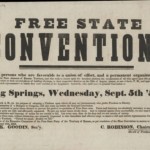One of the three major routes for slaves escaping north through Indiana passed through Jefferson County, on the Ohio River. Passengers on the Underground Railroad found a safe haven in Madison’s largely African-American Georgetown district, and a bastion of abolitionist activity just ten miles up the road, in the town of Lancaster.
Known as “the New England Settlement”, Lancaster had been established by a number of families from Vermont and Maine who routinely violated state law to convey escaping slaves to freedom. Although Indiana was not a slave-holding state, the fugitive slave law and a constitutional amendment prohibiting black migration into the state created a hostile environment for blacks and their allies in the mid-nineteenth century.
Jefferson County residents Robert Elliott, John and Sarah Tibbets, and Lyman and Aseneth Hoyt became known as “conductors” on the Underground Railroad. Their homes were recognized as “stations” where fleeing slaves could take shelter and seek escort to the next point along the way. The activists encountered a rabid opponent in the figure of Robert Right Rea, local sheriff and slavecatcher, who would return captured slaves across state lines to their owners for hefty recompense.
Lancaster abolitionist families banded together as the Neil’s Creek Anti-Slavery Society in 1839, and the Anti-Slavery Baptist Church in 1846. The group worked with other activists across the nation to put a Liberty Party candidate on the presidential ballot in 1840 and 1844. On the local level, Lancaster residents worked with Ohio preacher Thomas Craven to found the Eleutherian Institute in 1848.
Dedicated to the education of all regardless of race or gender, the institute took its name from the Greek word for freedom. By 1856, a large stone building with a belfry had been constructed, and the first students were enrolled, 18 of whom were African American. Measuring 65 feet by 42 feet, the structure was to “furnish a commodious chapel, rooms for literary societies and recitation rooms sufficient to accommodate 200 or 300 students.” Within two years, Eleutherian College was able to offer primary education, a college curriculum and instruction for teachers. By 1860, two hundred students attended the integrated institution, including 50 blacks from as far away as Louisiana and Mississippi.
The building functioned as a school until 1937, at which point it was abandoned. Recently designated as historic landmarks, Eleutherian College and the nearby Lyman Hoyt House play key roles in bringing the story of the Underground Railroad in Indiana to light.
This Moment of Indiana History is a production of the Indiana Public Broadcasting Stations in association with the Indiana Historical Society.
Writer: Yaël Ksander
Sources for this program include:
https://www.eleutherian.us/History.html
https://en.wikipedia.org/wiki/Eleutherian_College






















